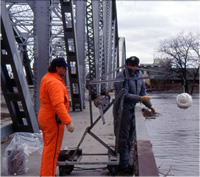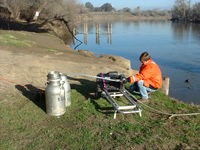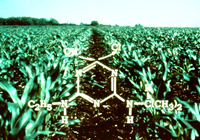One focus of the USGS Toxic Substances Hydrology (Toxics) Program is to investigate the occurrence and fate of agricultural chemicals in the environment from pesticides, fertilizers, veterinary medicines, and other sources.
A wide variety of Toxics Program investigations study the fate of agricultural chemicals either directly or indirectly. Toxics Program agricultural chemical investigations focus on:
- Characterizing the processes that affect the dispersal of chemicals in the atmosphere, ground water, and surface water
- Discovering the processes that control the fate of nutrients in the environment
- Identifying persistent pesticide degradation products
- Developing methods to measure these compounds in water samples at environmentally relevant concentrations
- Assessing the impact of hypoxia, eutrophication, and other processes on water bodies receiving drainage from agriculturally dominated watersheds
Results of these investigations are used by government regulators, pesticide manufacturers, farmers, water resource managers, and the public to set sound policy on the use of agricultural chemicals. The information presented on this page cuts across lines drawn by individual investigations and projects so that the information on the fate of agricultural chemicals can be presented in one place.
Investigations and Research Activities
Fact Sheets
- Herbicides in Midwestern Reservoir Outflows, 1992-93, USGS Fact Sheet 134-98
- Herbicides in Ground Water of the Midwest--A Regional Study of Shallow Aquifers, 1991-94, USGS Fact Sheet FS-076-98
- Reconnaissance for Sulfonylurea Herbicides in Waters of the Midwestern USA: An Example of Collaboration Between the Public and Private Sectors, USGS Fact Sheet FS-046-98
- Occurrence of Cotton Pesticides in Surface Water of the Mississippi Embayment, USGS Fact Sheet FS-022-98
- Herbicides in Rainfall Across the Midwestern and Northeastern United States, 1990-91, USGS Fact Sheet FS-181-97
- Agricultural Chemicals in Iowa's Ground Water, 1982-95 -- What are the Trends?, USGS Fact Sheet FS-116-97
- Nitrogen in the Mississippi Basin--Estimating Sources and Predicting Flux to the Gulf of Mexico, USGS Fact Sheet FS-135-00

USGS technicians collecting water samples from a bridge for a reconnaissance of herbicide concentrations in streams
(Click on Image for a Larger Version)
|
Headlines

An autosampler set up to collect water samples for analysis of pesticides during storm events as part of a reconnaissance of stream waters in peanut production areas in the southeastern United States. The autosampler was located on Black Creek near Blitchton, GA (circa 2003)
(Click on Image for a Larger Version)
Bibliography
Publications on Agricultural Chemicals (650 Publications)
New Publications

The analysis of pesticides sometimes requires large-volume water samples to detect pesticides that are toxic at low concentrations. This is a view of a pump used to collect samples from the San Joaquin River near Vernalis, CA (circa 2000). The sampling effort was part of a project to study pesticides and other anthropogenic chemicals in the San Francisco Bay/Delta
(Click on Image for a Larger Version)

Diagram of an Atrazine molecule showing replacement of its chlorine atom with a hydroxyl group. Hydroxyatrazine is a metabolite of Atrazine commonly found in ground water. Atrazine is a herbicide used on corn and sorghum. Atrazine and other herbicides were studied as part of a reconnaissance of herbicide concentrations in streams
(Click on Image for a Larger Version)
|